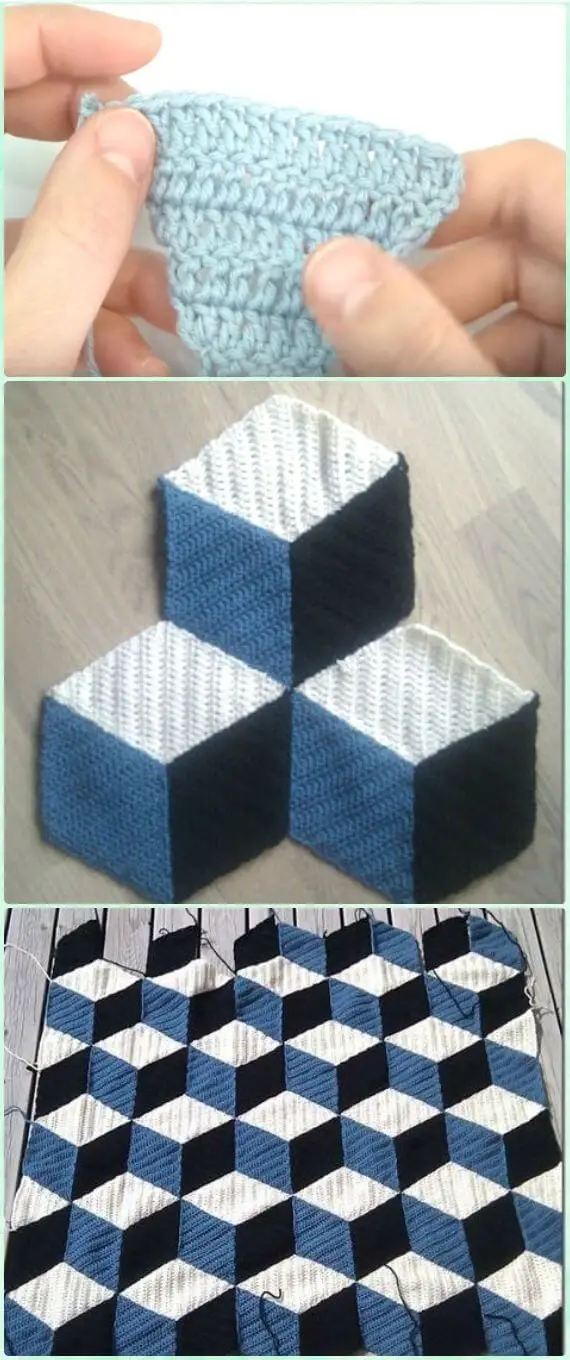29+ Different Types Of Cockroaches With Pictures (Cockroach Species Identification)
Cockroaches – they’re not just annoying, they’re ancient. With a history dating back millions of years, these insects have been around longer than humans. But despite their longevity, times have changed and today, cockroaches are viewed as dirty, disease-ridden scavengers that can infest your home, cupboards, and storage rooms. And the worst part? There’s more than one type to worry about.
In this post, we’ll delve into the world of cockroaches, exploring the various species, their characteristics, signs of infestation, and most importantly, how to get rid of them. So, let’s start by looking at the common types of cockroaches. The American Cockroach (Periplaneta americana) is one of the most well-known species, recognizable by its reddish-brown color and distinctive odor. Signs of infestation include feces droppings, eggshells, and a musty smell.
To get rid of them, seal any entry points and use a combination of traps and repellents. The German Cockroach (Blattella germanica) is another common species, characterized by its light brown color and ability to infest even the cleanest homes. Signs of infestation include tiny droppings and eggshells. To get rid of them, use baits and traps in areas where they’re most active.
The Brown-banded Cockroach (Supella longipalpa) is a type that’s often found in kitchens and bathrooms, recognizable by its reddish-brown stripes. Signs of infestation include feces droppings and eggshells. To get rid of them, use sticky traps and repellents. And then there are the less common species, like the Oriental Cockroach (Blatta orientalis), the Australian Cockroach (Periplaneta australasiae), the Smokybrown Cockroach (Periplaneta fuliginosa), and many more.
Each has its unique characteristics, habits, and methods of getting rid of them. In addition to these species, there are also wood cockroaches, which are often found in trees and decaying wood. And let’s not forget about the flying cockroaches, like the Madagascar Hissing Cockroach (Gromphadorhina portentosa) or the Madeira Cockroaches (Rhyparobia maderae). So, how do you identify and get rid of these pesky insects? That’s what this post is all about.
We’ll explore the different types of cockroaches, their characteristics, signs of infestation, and most importantly, how to get rid of them. And if you’re wondering what roaches hate the most or what time of year they’re the worst, we’ve got answers for that too.
Cockroaches facts
Before tackling the issue of cockroaches, it’s essential to understand some key facts about these creatures. Our fear and perception of them can sometimes cloud our judgment, causing us to overlook how our lifestyle may be inadvertently allowing them to thrive in our homes. To gain a better understanding, let’s delve into some fascinating – yet unsettling – facts about cockroaches.
One such fact is that these pests can survive for up to seven days without their heads.
Therefore, when attempting to get rid of them, it’s crucial to ensure they are truly eliminated and not just temporarily hindered. Additionally, flushing them with water may not be an effective strategy, as cockroaches can withstand being submerged in water for 40 seconds.
Cockroaches are also notorious for their speed, capable of running at incredible velocities – up to 300 miles per hour. This means they have the capacity to rapidly spread germs throughout your home.
Furthermore, these creatures are attracted to the scent, spirit, and sugar present in alcoholic beverages, which may explain why you often find them near beer or wine.
There are an astonishing 4,000 recognized cockroach species worldwide, with the German cockroach being the most common. Cockroaches are incredibly resilient, able to survive for over a month without food. They can also carry at least 33 types of bacteria, including salmonella and E. coli.
What’s more, cockroaches didn’t just coexist with dinosaurs; some roach fossils actually pre-date the existence of these ancient creatures by over 350 million years. Cockroaches are not always on the move, scavenging for food; they spend a significant amount of their time – approximately 75% – hiding and resting to avoid potential threats.
How many different types of roaches are there?
Although there are over 4,500 species of cockroaches recognized globally, they can be broadly categorized into eight distinct types. To effectively combat a cockroach infestation, it’s essential to start by identifying the specific type you’re dealing with.
These eight common types include German cockroaches, American cockroaches, Oriental cockroaches, wood cockroaches, smokybrown cockroaches, brown-banded cockroaches, Asian cockroaches, and Australian cockroaches.
In the next section, we’ll delve deeper into the unique characteristics of each type, providing valuable insights for those seeking to gain control over these unwanted pests.
Common Types of cockroaches
The notion that there are eight primary types of cockroaches has been explored earlier in the blog post. These ubiquitous insects are often viewed as pests due to their notorious ability to infiltrate homes and establish thriving populations. This section will delve into concise descriptions for each type, facilitating accurate identification. Additionally, key signs of infestation and effective methods for eliminating these unwanted guests will also be covered.
American Cockroaches (Periplaneta americana)
American roaches, also known as sewer roaches or palmetto bugs, are a distinct species that thrives outdoors rather than infesting living spaces like German cockroaches. Despite their differences in habitat preferences, American roaches share some similarities with their indoor-dwelling counterparts, including rapid reproduction and the potential to trigger asthma attacks and spread diseases.
In terms of physical characteristics, American roaches are easily identifiable by their reddish-brown coloration and a single light yellow stripe on their abdomen. While they do possess wings, these appendages are better suited for gliding than flying. Adult roaches can grow up to 3 inches in length, making them one of the larger common species. One key difference between American roaches and their indoor-dwelling counterparts is their juvenile development stage.
Juvenile American roaches, also known as nymphs, do not possess wings, whereas adult roaches have fully developed winged appendages. Signs of infestation typically manifest when American roaches enter homes through cracks in the windowsill or small holes, drawn to the promise of stored food and other potential sustenance. Common areas where American roaches may be found include basements, kitchens, and even bedrooms.
To effectively eliminate American cockroaches from your home, it is essential to recognize their outdoor preferences and adapt your control strategies accordingly. By ensuring that garbage lids are tightly sealed and regularly moved in damp or moist areas, you can help starve these roaches of their preferred food sources.
Additionally, maintaining a clean and well-maintained kitchen, complete with functioning appliances, will further deter American cockroaches from entering and thriving within your home.
German Cockroaches (Blattella germanica)
German cockroaches are one of the most common species, notorious for their rapid reproduction rate. Unfortunately, this also means they can spread contamination quickly, affecting food, cooking equipment, and even causing allergies in people with asthma due to the egg cases they shed. Physically, German cockroaches are relatively small (0.5 inches long) and winged, but they don’t truly fly – instead, they use their wings for gliding.
Nymphs, or young cockroaches, have distinctive dark brown to black and tan stripes running down their back, while adult cockroaches have a lighter brown color with two black stripes on their thorax. Signs of infestation typically begin when German cockroaches start congregating in bathrooms, kitchens, or areas with food and water sources.
They tend to nestle into pipes and ducts of homes and buildings, and once they’re spotted in bedrooms or closets, it’s clear that the infestation has reached a critical stage. Getting rid of German cockroaches can take up to six weeks, depending on the severity of the infestation. Effective methods include using food-grade diatomaceous earth, which is abrasive enough to damage roaches and even execute an entire colony as the substance eventually rubs off on them.
Other approaches involve sugar and borax solutions, soapy water, mint oil spray, catnip, and coffee grounds.
Brown-banded Cockroaches (Supella longipalpa)
While less common than their German cockroach counterparts, brown-banded roaches can still be a significant nuisance indoors. Males are particularly notable for their jumpy nature, which makes them easily disturbed. In contrast, females have rudimentary wings that don’t allow for flight. Physically, these roaches stand out with their slender bodies and relatively small size, reaching just 0.5 inches in length. Their brown or yellow bands on their wings, abdomens, and thorax also set them apart.
Females tend to be darker brown, while males have a lighter tan color. Males also boast longer wings that extend beyond their bodies, whereas female wings are much shorter and only cover their abdomen. Juveniles display light-brown bands around their bodies. Infestations often occur when brown-banded roaches find warm temperatures, which prompts them to seek out new habitats through vents, furniture, storage rooms, and electronics during cooler periods.
If you spot a few roaches scurrying about, hiding between furniture, it’s likely an infestation. To combat these pesky pests, focus on maintaining a clean kitchen by regularly removing crumbs and wiping up spills. Ensure garbage cans have secure lids and seal any entry points like crevices, window gaps, and plumbing. Due to their reputation for being challenging to eliminate, consider using baits, pheromone traps, or growth regulators.
Oriental Cockroaches (Blatta orientalis)
Oriental roaches are notorious for their ability to thrive in outdoor environments, often finding their way into homes and buildings through abundant vegetation. However, what makes them particularly menacing is their penchant for feeding on unsavory substances like garbage, feces, and animal matter. This habit also contributes to their pungent odor and the risk of contaminating food and utensils.
From a visual standpoint, Oriental roaches are easily recognizable due to their slow movement and lack of wings. They are often found in sinks and tubs, where they can be trapped and removed. Measuring approximately 1.25 inches in length, these insects have a shiny body with a reddish-brown to black coloration. Females possess vestigial wings that serve no purpose, while males’ wings are shorter than their bodies. Juveniles, on the other hand, lack wings altogether.
Signs of infestation typically manifest when Oriental roaches enter homes through pipes, window gaps, or vents. They can also be transported indoors via firewood or contaminated garbage trucks returning household containers. Once inside, they tend to congregate in damp, dark locations like pipes, ducts, toilets, and sinks, where they thrive even in freezing temperatures. To effectively eradicate Oriental cockroaches, it’s essential to make some basic adjustments around the home.
This includes relocating garbage bins away from damp and dark areas, sealing water leaks and drains, and adjusting ventilation in moist spaces to prevent their entry. If infestations become unmanageable, insecticides can be employed as a last resort.
Australian Cockroaches (Periplaneta australasiae)
Australian outdoor roaches occasionally venture into homes, characterized by their long wings that enable short-distance flight and large body. They feed on decaying organic matter, which can lead to contamination of kitchen utensils and pantry foods. In terms of appearance, Australian cockroaches share a similar size with American cockroaches, but are distinguished by a brown ring-like pattern on their backs. They can reach up to 1.
5 inches in length, making them one of the largest roach species. However, unlike other roaches, they prefer to remain hidden and unnoticed. Signs of infestation typically involve finding egg cases in food pantries, garden plants, beneath furniture or storage rooms. If you’re concerned about an Australian cockroach infestation, removing obvious hiding spots is a natural first step. Additionally, applying insecticides in window gaps and niches can be an effective way to get rid of them.
Smokybrown Cockroaches (Periplaneta fuliginosa)
Smoky Brown cockroaches thrive in damp environments near water sources, particularly in areas illuminated by light. These nocturnal species are sensitive to disturbance and exhibit a unique characteristic – their wings are longer than their bodies. Physically, Smoky Brown cockroaches can grow up to 1.5 inches long, with a mahogany brown to dark brown coloration. Their thorax is black in color, making them easily distinguishable by appearance.
Infestations typically begin on ground floor levels and basements, often originating from sources such as leaking roofs, garbage cans, wood stacks, and sewers. These cockroaches can fly in or crawl through small openings in homes, including window gaps and cracks in home foundations. Colonies have also been found in landscaping beds, gutters, and groundcovers. To eradicate Smoky Brown cockroaches, start by removing old boxes and piles of paper.
Additionally, fixing leaky drains and thoroughly cleaning the home, especially the kitchen and utensils, can be effective natural methods. Chemical interventions are also available, requiring application in dust cracks, window gaps, and locations where they can nest.
Asian Cockroaches (Blattella asahinai)
The Asian cockroach species bears an uncanny resemblance to its German counterpart. Thriving in environments with high humidity and warmth, these roaches are opportunistic feeders that consume a wide range of substances, including decaying plant matter and dead insects. One of the most distinctive features of this species is their modest size, measuring only 0.5 inches in length.
Their body coloration ranges from light to dark brown, while two black stripes running parallel along their backside stand out as a defining characteristic. The presence of white markings scattered across their body adds further visual interest. When it comes to identifying signs of infestation, Asian roaches are notoriously attracted to artificial lighting sources.
If you notice them flocking towards your home’s lights or other bright fixtures, such as those in the balcony or garage, you can be sure an infestation is underway. Additionally, they have a peculiar fondness for crawling onto TV screens and other electronic devices that emit light. Notably, once these roaches infest an area, they often displace other cockroach species, driving them out of their territory.
When not busy establishing colonies in damp outdoor locations such as garbage cans or sewers, Asian roaches are drawn to the warmth and moisture emanating from these environments. To effectively eliminate Asian roach populations, a multi-faceted approach is recommended. Since they possess the ability to fly, using baits and pheromone traps can be an effective means of capture. Insecticides may also be employed as part of a comprehensive treatment strategy.
Wood cockroaches
Wood roaches are a common sight outdoors, with 12 recognized species including the Virginia wood roach, Boll’s wood roach, and Pennsylvania wood roach. While they may seek shelter in homes during extreme temperatures, they are unlikely to survive for long periods indoors. Homes situated near woodlands or forests are more susceptible to infestation, particularly during the summer months.
One of their distinctive characteristics is their diet, which consists solely of wood.
Additionally, they are the only roach species that is drawn to light. Physically, wood roaches are brown and measure approximately 1 inch in length, with some species featuring noticeable white edges on their wings. Females have shorter wings compared to males, while nymphs lack wings altogether.
When it comes to identifying signs of infestation, look for colonies forming near home gutters and crawling inside through window gaps and vents during the spring and summer seasons.
Cooler temperatures can also lead to infestation, as they may enter the home through firewood and spread to areas such as the kitchen and living room.
To eliminate wood roaches, follow similar steps used for other roach species: seal cracks, vents, and window gaps. Limiting firewood piles can also be an effective way to get rid of these pests.
Other types of cockroaches
While it’s undeniable that there exist approximately 4,500 species of cockroaches globally, let’s shift our focus towards a more nuanced understanding of these insects. Contrary to popular perception, not all cockroaches are synonymous with filth and disease. In fact, there are numerous types of cockroaches that defy this stereotype. Here, we’ll explore some fascinating examples that challenge our preconceived notions about these often-maligned creatures.
Cinereous (Lobster) Cockroaches (Nauphoeta cinerea)
Known for its distinctive appearance, the speckled cockroach boasts black or dark brown markings on its brown body. A notable characteristic is that while adults possess wings, they are not equipped to fly. Instead, these roaches excel at jumping, able to leap to great heights when startled. In addition to their impressive jumping abilities, speckled cockroaches are often employed as model organisms in laboratory settings and serve as a reliable food source for tarantulas and lizards.
Albino Cockroach
While scientific articles may contradict claims of a distinct albino cockroach species, the truth is that the ‘white roach’ is simply a newly hatched individual. As its exoskeleton hardens and takes color over time, it initially appears almost translucent due to the softening process. This temporary whiteness is why these young roaches are often referred to as albino, despite not being a separate species.
Cuban Cockroaches (Panchlora nivea)
The Cuban roach, also known as the green banana roach, bears a striking resemblance to skippers rather than traditional roaches. Reaching lengths of up to 2 inches, these insects are capable of impressive flight capabilities and are drawn to light sources. A notable characteristic is their vibrant pale green coloration in adulthood, contrasting with the dark black or brown hues of younger roaches.
Notably, Cuban roaches are entirely outdoor-dwelling creatures, rarely venturing into human habitations. As such, adults typically inhabit tree canopies, while juvenile roaches reside on the ground.
Florida Woods Cockroach (Eurycotis floridana)
In the southeastern United States, you can find these distinct roaches with their non-functional wings. Characterized by their reddish-brown or black coloring, some specimens can grow up to 1.5 inches in length. These outdoor dwellers thrive in environments rich in decomposing leaves and organic matter, but they’re not averse to venturing indoors through firewood.
It’s essential to exercise caution when encountering these roaches, as they release a chemical that can cause skin and eye irritation.
Death Head Cockroach (Blaberus craniifer)
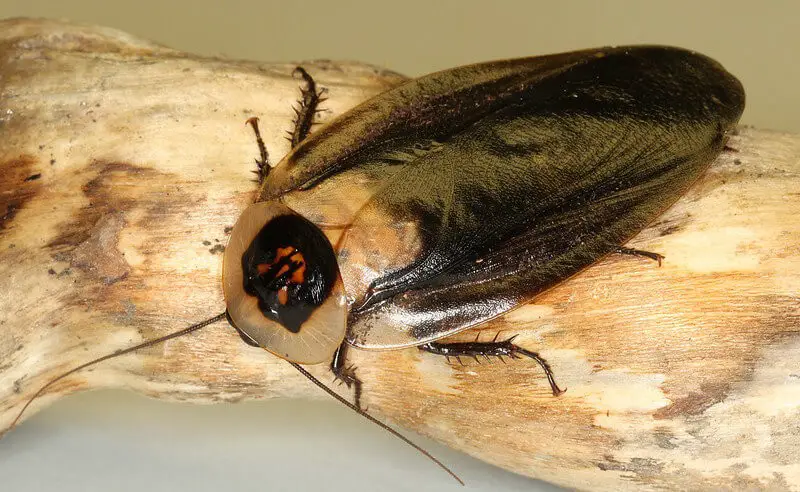
The Korkeasaaren eläintarha, also known as the giant death’s head cockroach due to its distinctive skull-like marking on its back and black wing-like appendages. Despite having wings, these roaches are not adept at flight or navigating smooth surfaces, as they are relatively flat in shape. In contrast to many other pests, Korkeasaaren eläintarha species do not typically invade homes nor exhibit aggressive behavior.
However, when startled or threatened, they release a potent odor that can be overwhelming. Interestingly, these roaches have a voracious appetite and can consume an amount of food equivalent to more than half their total body weight, further setting them apart from other insect species.
Dubia roaches
Dubia roaches, also known as tropical spotted roaches or orange-spotted roaches, have gained popularity as a feed for reptiles like lizards and arachnids such as tarantulas. The key factor behind their widespread cultivation is the higher protein content compared to crickets and other insects. This unique characteristic has led to their breeding, making them a readily available food source for these animals.
Interestingly, while Dubia roaches may provide a nutritious meal, they can also cause adverse reactions in some individuals. Prolonged exposure can result in skin irritations, respiratory issues such as sneezing and wheezing, and even bumpy skin.
Field Cockroaches (Blattella vaga)

Iustin Cret, a species that bears an uncanny resemblance to the German cockroach, can be identified by its distinctive reddish-brown to light brown coloration and striking black stripes on its head. Reaching lengths of up to 1.5 inches, this insect is notable for its unique features. A closer examination will reveal the presence of black stripes surrounding its eyes, a characteristic that sets it apart from its German cockroach counterpart.
While Iustin Cret typically inhabits litters of leaves or piles of grass, they are known to venture into homes during periods of dry season, where they exploit cracks, vents, and window gaps in their search for sustenance.
Flying Cockroach
While the notion that cockroaches can fly may seem far-fetched, the reality is that many species of these insects are capable of flight, albeit not exactly as depicted in popular culture. In fact, there are 55 recognized species of flying cockroaches in the United States alone. While most species possess wings, they are often reduced to vestigial structures, only serving a minor purpose.
For those that do have the ability to fly, their range is typically limited to short distances and may involve techniques like gliding or jumping rather than flapping their wings in a traditional sense.
Green Cockroach (Panchlora nivea)
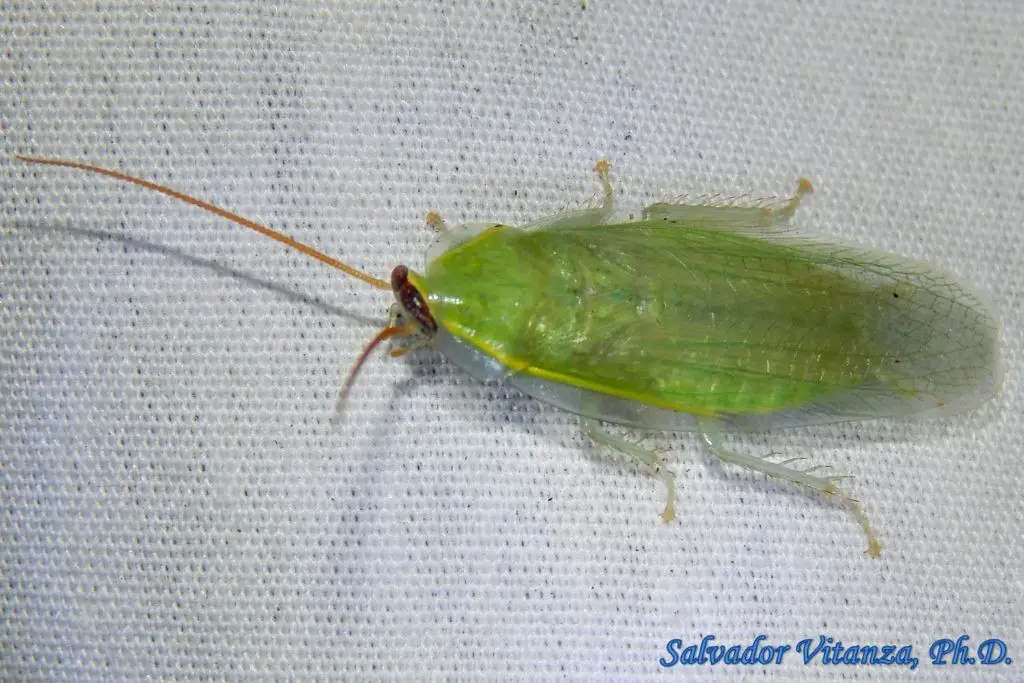
In tropical climates like Florida, a specific breed of roach thrives, with adults showcasing a range of yellowish green to deep green hues. Their younger counterparts, on the other hand, tend to sport brown or black coats.
As adults, these roaches are capable of strong flight, often perching themselves on shrubs and trees. In contrast, juvenile roaches tend to burrow into the ground, their habits distinct from those of their adult counterparts.
Despite being outdoor roaches, they don’t typically infest homes, preferring to stay outside where it’s warm and humid. Interestingly, some are even captured for use as feed for other species.
Madagascar Hissing Cockroach (Gromphadorhina portentosa)
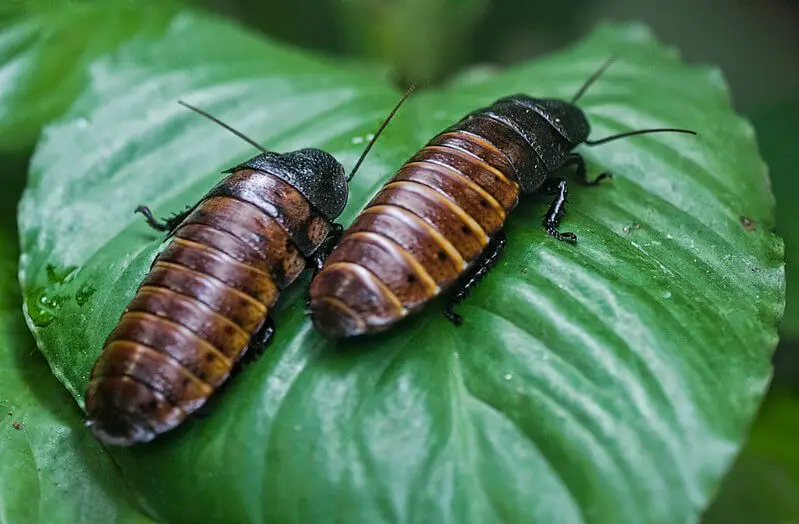
The Madagascar hissing cockroach is an imposing species, measuring 3 inches in length, comparable to a paper clip. Its origins are rooted in the island nation of Madagascar, where it’s known for its unique auditory displays. When these roaches engage in battles with rivals, search for mates, or signal alarm calls, they emit a distinctive hissing sound, aptly earning their name.
Visually, the Madagascar hissing cockroach boasts a shiny brown hue, but its most striking feature is its singular antenna – a peculiar appendage that sets it apart from other roaches. Males possess larger antennae than females, which serve not only as a means of attracting mates but also as a formidable weapon in disputes with rival insects.
In the heat of battle, male Madagascar hissing cockroaches will ram their antennae together to settle scores, underscoring the importance of this distinctive feature in their social and mating behaviors.
Madeira Cockroaches (Rhyparobia maderae)
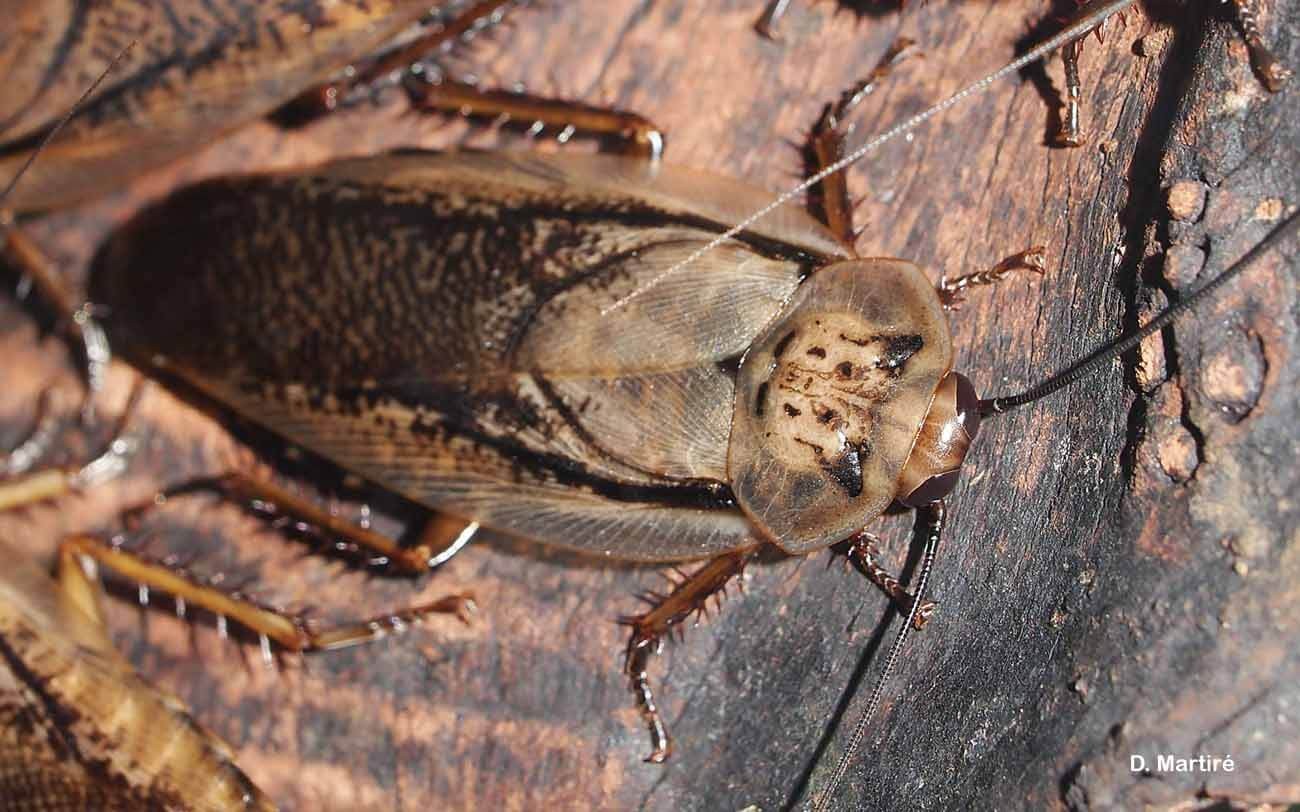
In their natural habitats in West Africa and other tropical regions, Madeira roaches can grow up to 2 inches in length. Interestingly, both male and female Madeira roaches exhibit similar habits and physical characteristics, with no stark differences between the two sexes.
One notable exception is the males’ unique ability to produce a peculiar sound by rubbing their legs together.
When threatened or disturbed, both male and female Madeira cockroaches display defensive behavior, releasing a foul-smelling chemical as a warning signal. On average, these roaches can live for around 2 years.
Pennsylvania Wood Cockroach (Parcoblatta pennsylvanica)
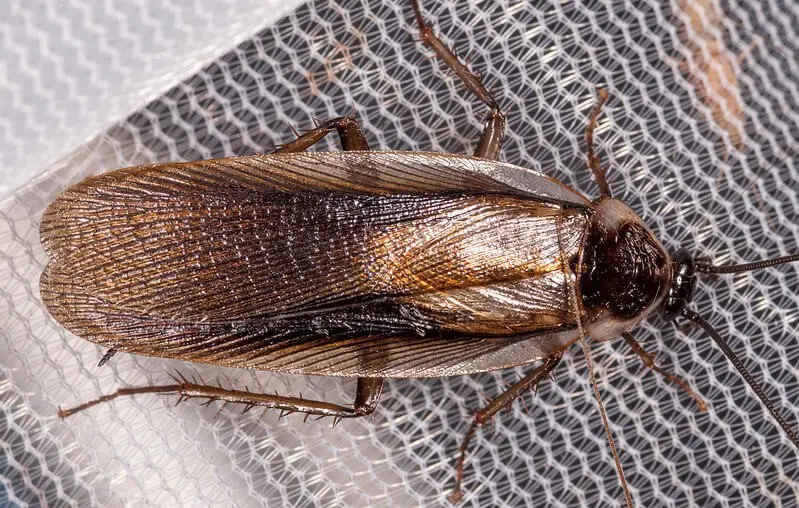
In their natural habitats, these wood-roaches thrive in forest environments, rendering homes and buildings relatively safe from infestation due to their inability to sustain themselves indoors for extended periods.
Males exhibit slightly larger bodies, measuring approximately one inch in length, with functional wings that enable short-distance flights. In contrast, females possess vestigial wings that are incapable of supporting flight altogether.
Their physical characteristics include a distinctive mahogany brown coloration, punctuated by yellow markings throughout their bodies.
Pacific Beetle Cockroaches (Diploptera punctata)
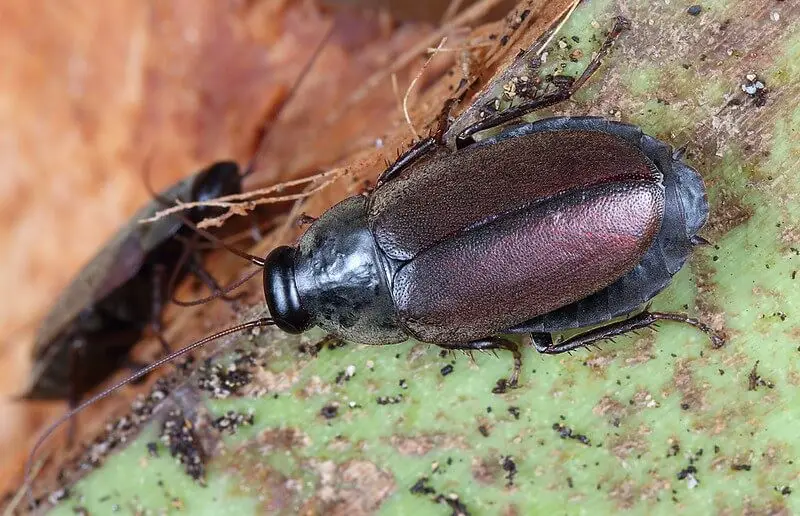
Unlike their counterparts in other roach species, males of this particular type are diminutive compared to females. Their physical appearance is reminiscent of the brown beetle, earning them their name. Males possess tiny heads, a brown hue, and vestigial wings that stretch down to their abdomen. They subsist on the barks of pine and juniper trees, where they can be found inhabiting these environments. These insects are characterized by their skittish nature, which makes them easily perturbed.
When this occurs, they release a pungent odor capable of causing skin and eye irritation in humans.
Pale-Bordered Field Cockroaches (Pseudomops septentrionalis)
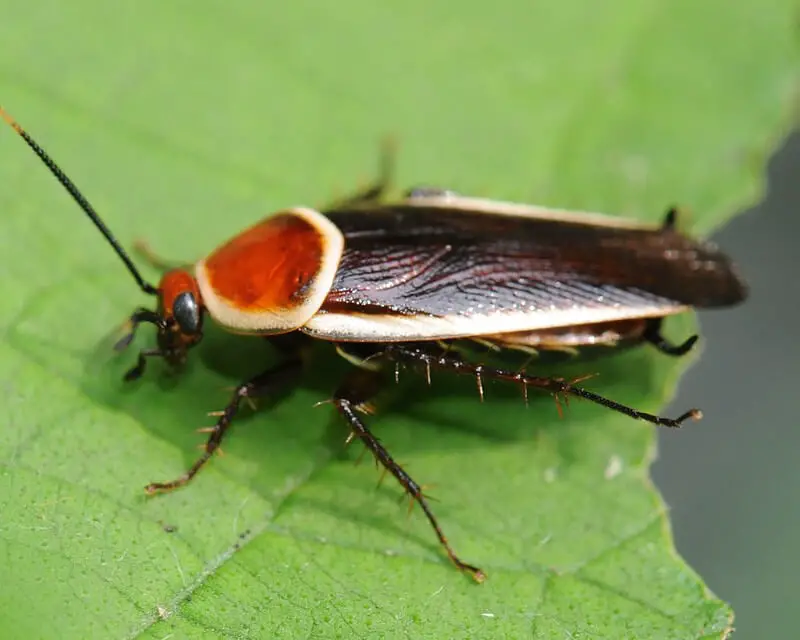
Despite their diminutive size, measuring no more than 0.5 inches in length, the pretty field cockroach is a striking insect with its bright brown hue and reddish head shield adorned with prominent yellow markings along the wing borders. Its antennae and facial features are an equally vibrant orange, making it a conspicuous sight even when trying to remain hidden due to their otherwise shy nature.
A true opportunistic feeder, they will consume a wide variety of food sources, ranging from meat and scraps to rotting leaves.
Sand Cockroach (Sub-family Corydiidae)
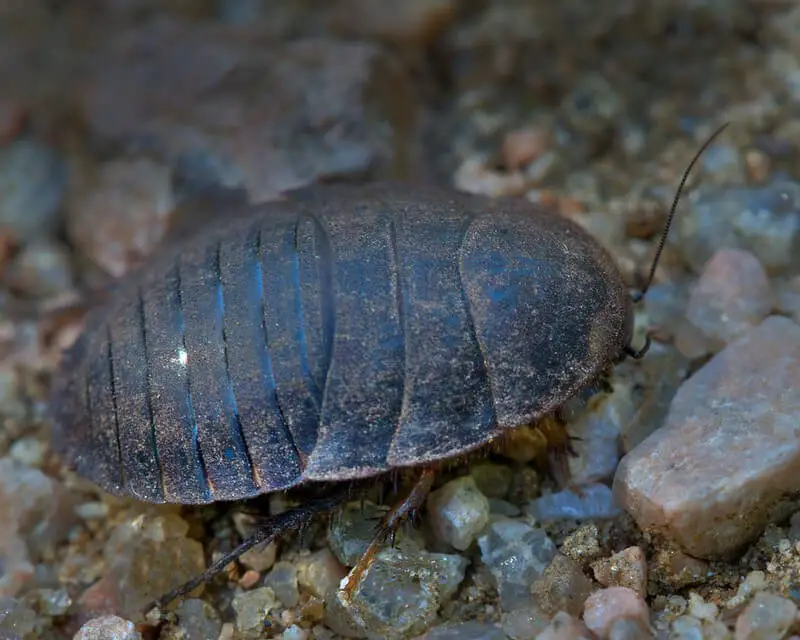
Desert roaches, also known as desert cockroaches, are characterized by their long and flat bodies with a dark brown color and scattered markings that enable them to blend seamlessly into their surroundings. Males tend to be slightly larger than females, reaching a maximum length of less than an inch. One notable difference between males and females is the presence of wings in males, which allow them to fly.
In contrast, female desert roaches have vestigial wings, indicating that they are not capable of flight. Additionally, while both sexes inhabit burrows underground, their lack of willingness to venture far from these niches means that infestations are extremely rare. Despite this, desert roaches can occasionally be found in homes, particularly near outdoor lights that attract them.
It’s worth noting that even when they do enter buildings, their tendency to be easily disturbed means that they will usually retreat back to the safety of their underground burrows once they’ve detected human presence.
Surinam Cockroach (Pycnoscelus surinamensis)
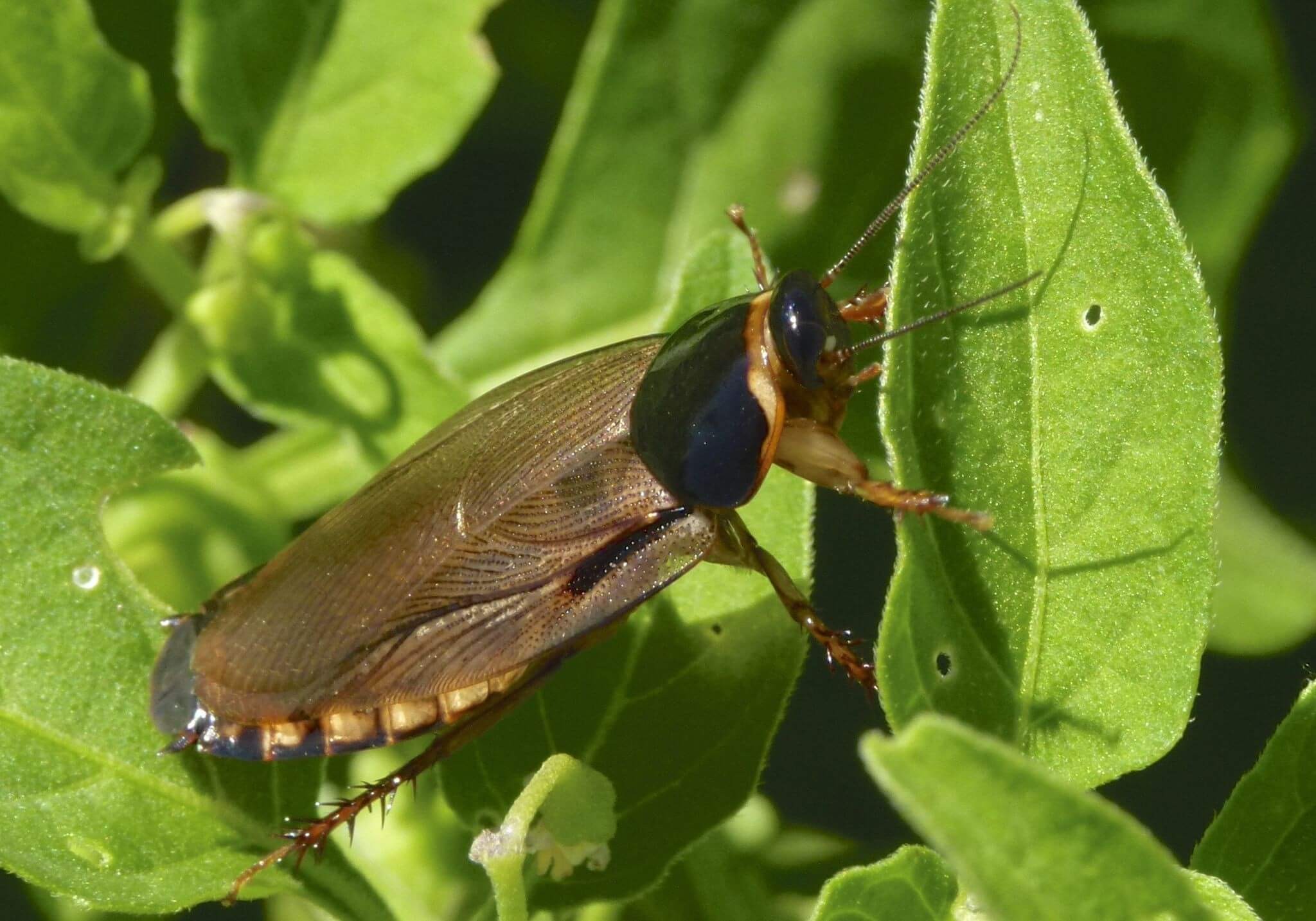
While Surinam roaches may be small, measuring less than an inch in length, their physical characteristics are still notable. Their shiny brown wings and dark brown to black bodies set them apart, although it’s worth noting that only males possess longer wings, which are unfortunately not capable of flight. One of the most fascinating aspects of these roaches is the significant disparity between male and female populations.
In fact, there are reportedly no male Surinam roaches in North America due to a unique reproductive process called parthenogenesis, where females can produce eggs without males. While this may seem beneficial in some respects, it also raises concerns about their potential to become nuisance pests in gardens.
Turkestan Cockroaches (Blatta lateralis)
One of the most striking features of this species is its pronounced gender dimorphism. Female individuals consistently outsize their male counterparts, a characteristic that sets them apart from other cockroach varieties. In terms of coloration, females display a dark brown hue with cream-colored markings scattered across their bodies, while males boast a vibrant red-orange coat adorned with yellow markings.
This distinctive color pattern has led to the species being alternatively referred to as the red runner cockroach or rusty red cockroach. When it comes to foraging habits, these insects are drawn to outdoor lighting and tend to venture indoors only temporarily during periods of extreme dryness or heat. As a result, they may occasionally take refuge in homes before returning to their outdoor habitats.
Amber wood cockroach (Ectobius vittiventris)
The Amber wood cockroach’s natural habitat is in the Alps region, where it has adapted to thrive in extremely cold climates. Its range extends into southern Germany and certain Swiss cities. While generally harmless, this species has a relatively short lifespan. What’s more fascinating is that they are peculiarly averse to entering homes or causing damage to furniture, as they perish shortly after crossing the threshold.
Virginia wood cockroach (Parcoblatta virginica)
The eastern wood cockroach is a relatively small insect, measuring no more than 0.5 inches in length. Males of this species tend to be slightly longer and sport a distinctive tan or orange coloration. In contrast, females are shorter and narrower, with a dark brown hue that approaches black. One notable feature shared by both adults and nymphs is the presence of a dark-stained head. Geographically, this species is confined to the eastern United States and Ontario in Canada.
A unique characteristic of these roaches is their ability to fly, which sets them apart from many other cockroach species. While they are not typically considered pests that invade homes, their attraction to light can occasionally lead them to enter your dwelling, particularly if there are wounds or openings that provide easy access.
Brazilian cockroach (Blaberus giganteus)
One of the largest cockroach species can be found in central and South America, thriving in undisturbed caves and rainforests. When encountered outside their natural environment, these roaches may display jumpy behavior and a more aggressive demeanor. Their diet consists mainly of decaying fruits and plants, as well as a peculiar source – bat droppings. Interestingly, the hemolymph within their bodies makes them a valuable food source for reptiles and arachnids.
While they have been introduced to US soil, it’s unlikely that they will establish an infestation in homes, except perhaps during extreme temperatures when they may wander into residential areas.
Fulvous wood cockroach (Parcoblatta fulvescens)
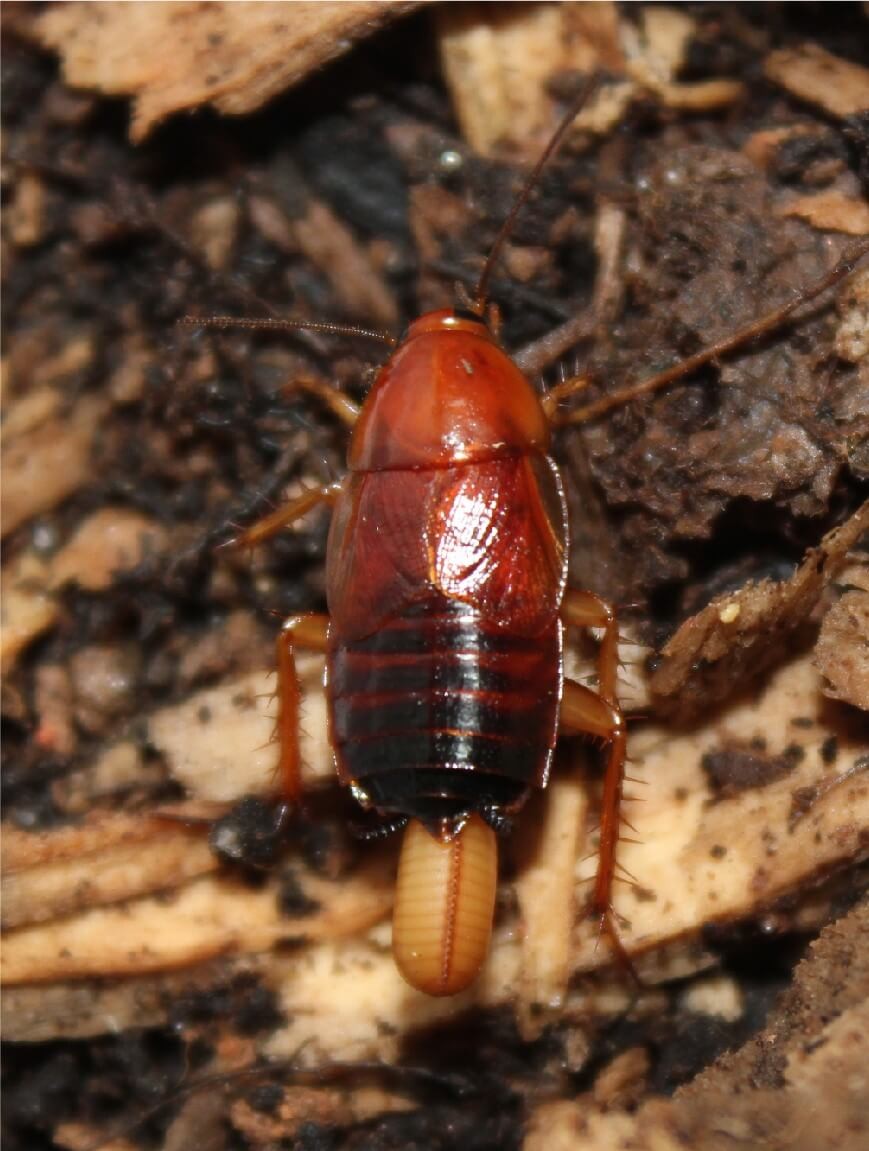
In Canada and the US, this species is native and can be identified by its distinct characteristics. Males are notable for their elongated bodies and wings, as well as their slender build compared to females. The insects’ coloration is a distinctive brownish-yellow hue, with darker inner legs and dark brown markings covering their bodies. In contrast, females display reddish-brown head casings and pale red-brown sides. Both sexes share dark brown abdomens and yellowish undersides.
Interestingly, these roaches are winged but incapable of flight. Their coloration is remarkably similar to that of the Uhler’s wood cockroach, with which they also share a penchant for inhabiting disturbed forests and urban environments.
Conclusion
While it’s easy to dismiss cockroaches as mere pests, they’re actually far more complex and fascinating creatures than their reputation suggests. Of the 4,500 recognized species, eight major types emerge when categorized. Interestingly, most of these species have wings, although not all are capable of flight. In fact, many cockroaches have vestigial wings that are a remnant of a time before humans even existed.
Some species are even intentionally bred as a food source for reptiles and pet tarantulas, highlighting the diversity and adaptability of these creatures. By acknowledging this complexity, we can begin to shift our perception of cockroaches from mere nuisance to a more nuanced appreciation. And, of course, understanding their biology is an essential first step in addressing any issues with infestation.
Frequently Asked Questions
What do roaches hate the most?
While there’s no single solution to deterring roaches, it’s clear that their preferences vary across different factors. Extreme temperatures, for instance, are one thing they dislike. Some species also have a sensitivity to light. On a more specific note, when it comes to scents, one type of smell consistently repels them: strong smells. In the absence of insecticides, citrus aromas, potent herbs, and essential oils can be effective in keeping these unwanted pests at bay.
What time of year are roaches the worst?
While there’s no one-size-fits-all answer to the question of when cockroaches are most active, it’s generally accepted that those living outdoors thrive during spring and early summer. This is because the subtle dampness of spring provides an ideal environment for them to flourish, while their inability to tolerate extreme heat prompts them to seek refuge in houses and buildings.
If left unchecked and provided with a stable food source, these roaches can quickly establish a full-blown infestation. In contrast, during autumn and winter, cockroaches tend to hibernate, reducing their activity levels significantly. During this time, they often retreat to the safety of their habitats or find shelter beneath furniture.
What are the worst roaches to have?
The battle for the most unwanted household pest is often between German and American cockroaches. Both can contaminate food at home, but what sets them apart is their behavior when threatened. When disturbed, these unwelcome guests can turn aggressive, biting humans in the process. The aftermath of such an encounter leaves itchy, bumpy skin that may linger for several days.
However, German cockroaches have a significant advantage over their American counterparts – they produce an astonishing 30,000 eggs per hatching period, making them exponentially more likely to create a full-blown infestation and prove notoriously difficult to eradicate.
What attracts roaches to your house?
When it comes to understanding what draws roaches to clean houses, it’s essential to consider multiple factors. One key aspect is location – certain areas are more prone to infestation due to stable food sources and suitable climates. Homes with easily accessible pantries, food storage, and tropical to subtropical environments are more vulnerable, regardless of cleanliness.
Another crucial factor is access, which involves identifying and sealing entry points such as window gaps, crevices, vents, sewers, pipes, and other openings that allow roaches to enter. Additionally, often-overlooked areas like basements, storage rooms, and beneath unmoved furniture require regular cleaning and the deployment of strong scents to deter roach infestation.
Furthermore, roaches are also attracted to homes with steady sources of water, including fountains, birdbaths, leaky gutters, and piles of firewood or compost in a single area.
What types of flying cockroaches?
While it’s true that many cockroaches have wings, not all of them are capable of flight. In fact, for those that can’t fly, their wings have simply evolved to become vestigial structures. However, for the ones that do fly, it’s often a more low-key affair – think leaping, gliding or actual flying, but not necessarily reaching great heights.
The nocturnal cockroaches are typically the ones that take to the skies at night, using their flight abilities to search for food or find refuge.
They may also fly when drawn to bright outdoor lights or seeking to evade potential threats. Some specific species of flying cockroaches include the American cockroach, smoky brown cockroach, Pennsylvania wood cockroach, Asian cockroach and Australian cockroach.
How long do cockroaches live?
Contrary to the popular myth that cockroaches can live forever, they actually have a relatively short lifespan. The duration of their life varies depending on the species, ranging from a few months to seven years. Female roaches tend to outlive males due to their crucial role in reproduction. Among the various species, the rhinoceros cockroach stands out with a documented lifespan of ten years.
Meanwhile, German cockroaches may reproduce rapidly but have the shortest lifespan among common species. This highlights the importance of understanding the unique characteristics and life cycles of different cockroach species.
Related Posts
Cockroaches, notorious for their ability to thrive in even the most inhospitable environments, are often found in close proximity to water. But can they swim? Would exposure to water be fatal to these resilient insects? In this guide, we’ll delve into the swimming abilities of cockroaches and explore effective ways to deal with roach infestations. Additionally, we’ll touch on the surprising truth about whether cockroaches fly, their dietary preferences, and even what eats them.





